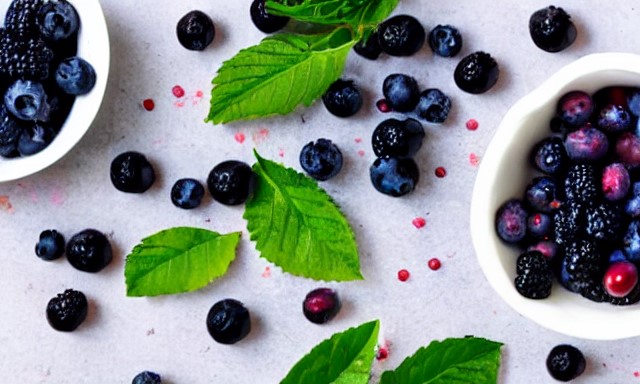Internet Asks: “Blue Fruits”
When it comes to fruits or vegetables, we often think of traditional colors like red, green, and yellow. However, blue fruits are a unique and nutritious option that should not be overlooked. Blue fruits and vegetables are not only visually appealing but are also packed with essential nutrients that offer a range of health benefits
From the exotic blueberry to the lesser-known blue corn, there are plenty of blue-hued fruits and vegetables that are worth exploring. In this article, we will delve into the world of blue foods, examining their unique characteristics and nutritional benefits.
Sponsored Links
Which Fruits and Vegetables Are Blue?

- Brilliant Blueberries: The Antioxidant Superstars
Blueberries are perhaps the most well-known blue fruit, prized for their sweet yet tangy taste and impressive nutritional profile. These delightful little gems are not only bursting with flavor but also packed with antioxidants, including anthocyanins, which give them their signature blue hue. They are also a good source of vitamin C, vitamin K, and dietary fiber. Blueberries have been linked to improved brain function, heart health, and even cancer prevention. Enjoy them fresh, frozen, or in smoothies, muffins, and salads for a delicious and nutritious treat. - Mysterious Midnight Blue Corn: An Ancient Gem
Blue corn may not be as well-known as blueberries, but it is equally deserving of recognition. Midnight blue corn, with its deep, mesmerizing hue, is an ancient grain revered by the Aztecs for its nutritional value. This corn variety is known for its striking blue color, which comes from anthocyanins, the same pigments that give blueberries their hue. Blue corn is rich in fiber, protein, and essential vitamins and minerals, making it a nutritious addition to any diet. It also has a low glycemic index, which means that it can help to regulate blood sugar levels and promote feelings of fullness. Transform midnight blue corn into mouthwatering tortillas, chips, or polenta for a colorful and nutritious twist on classic dishes. - Alluring Blue Potatoes: A Taste of the Extraordinary
Blue potatoes, with their striking blue flesh and earthy flavor, are an extraordinary addition to any meal. These colorful tubers are packed with antioxidants, particularly anthocyanins, and provide a good source of potassium and vitamin C. Experience the allure of blue potatoes by using them in dishes like mashed potatoes, baked chips, or vibrant potato salads.
Sponsored Links
- Dazzling Damson Plums: An Ancient Delicacy
Damson plums are a small, dark purple variety of plums with a slightly tart flavor, originating from the region around the Black Sea. They have been cultivated since Roman times and are commonly used in making preserves, jams, jellies, sauces, and desserts. They are rich in nutrients and antioxidants, particularly anthocyanins, which are responsible for their dark color. They are also a good source of vitamins, minerals, and dietary fiber, which can contribute to overall health and well-being. - Enchanting Elderberries: Immune-Boosting Magic
Elderberries are a lesser-known blue fruit that is native to Europe and North America. They are rich in antioxidants, flavonoids, and vitamin C, making them an excellent immune-boosting fruit. These tiny berries have been used for centuries in traditional medicine to treat colds and flu. Incorporate elderberry syrup or tea into your daily routine to unlock their magical health benefits.
- Intriguing Indigo Tomatoes: A Blue Twist on a Classic
While not as well-known as other blue fruits, indigo tomatoes are a unique and nutritious option. Their striking blue-black skin may look like they belong in a fantasy world, but they're very real and packed with health benefits. Rich in anthocyanins, indigo tomatoes have been linked to improved heart health and reduced cancer risk. They are also a good source of vitamin C, potassium, and fiber, and have been shown to have anti-inflammatory and anti-cancer properties. They can be eaten raw or cooked and are a great addition to salads and sauces. - Captivating Concord Grapes: Heart Health Heroes
Concord grapes, with their deep blue-purple color and sweet flavor, are more than just a tasty snack. They contain potent antioxidants called polyphenols, which have been linked to improved heart health and reduced inflammation. They are also a good source of vitamin C and fiber. Unleash their potential by enjoying them fresh or in the form of juice, jelly, or wine.
Conclusion
Blue fruits and vegetables offer a unique and visually stunning alternative to more traditional colors. With a wide array of blue-hued foods available, from well-known blueberries to the intriguing indigo tomatoes, there is an exciting world to explore. Each of these blue fruits and vegetables boasts impressive nutritional profiles, rich in antioxidants, vitamins, and minerals that contribute to overall health and well-being. So, the next time you're looking to add color and nutrition to your meals, don't forget to consider the enchanting and nutritious world of blue fruits and vegetables.
Sponsored Links
References
- "Blueberries: Health Benefits, Facts, Research" by Megan Ware, RDN, L.D. Medical News Today, 2021. https://www.medicalnewstoday.com/articles/287710#health-benefits
- Healthline. 7 Delicious Blue Fruits with Powerful Health Benefits. https://www.healthline.com/nutrition/blue-fruits
- Blueberries: Nutrition and Health Benefits. (2021). Healthline. Retrieved from https://www.healthline.com/nutrition/foods/blueberries
- CLEAN EATING KITCHEN. 13+ Best Blue Vegetables. https://www.cleaneatingkitchen.com/blue-vegetables/
People are also reading...
Does Sprite Have Caffeine?
Calories In Steak?
Chicken Taco Calories?
Does Hot Chocolate Have Caffeine?
Are Carrots Acidic?
Are Mangoes Acidic?
Orange Juice pH?
Does Kahlua Have Caffeine?
Calories In a Grilled Cheese?
Is Watermelon Acidic?
6 oz Steak Calories?
Are Strawberries Acidic?
Ready to level-up?
Create meal plans 10x faster, follow up with your clients through our mobile app, and never struggle with meal planning or recipe management again.